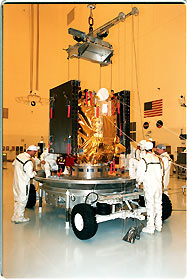
Enregistrez gratuitement cette image
en 800 pixels pour usage maquette
(click droit, Enregistrer l'image sous...)
|
|
Réf : S11707
Thème :
Essais - Constructions - Satellites - Sondes - Fusées (2314 images)
Titre : Workers in the Payload Hazardous Servicing Facility lower Deep Space 1 onto its
Description : (La description de cette image n'existe qu'en anglais)
(09/30/1998) -- Workers in the Payload Hazardous Servicing Facility lower Deep Space 1 onto its transporter, for movement to the Defense Satellite Communications System Processing Facility (DPF), Cape Canaveral Air Station, where it will undergo testing. At either side of the spacecraft are its solar wings, folded for launch. When fully extended, the wings measure 38.6 feet from tip to tip. The first flight in NASA's New Millennium Program, Deep Space 1 is designed to validate 12 new technologies for scientific space missions of the next century. Onboard experiments include a solar-powered ion propulsion engine and software that tracks celestial bodies so the spacecraft can make its own navigation decisions without the intervention of ground controllers. The ion propulsion engine is the first non-chemical propulsion to be used as the primary means of propelling a spacecraft. Deep Space 1 will complete most of its mission objectives within the first two months, but may also do a flyby of a near-Earth asteroid, 1992 KD, in July 1999. Deep Space 1 will be launched aboard a Boeing Delta 7326 rocket from Launch Pad 17A, Cape Canaveral Air Station, in October. Delta II rockets are medium capacity expendable launch vehicles derived from the Delta family of rockets built and launched since 1960. Since then there have been more than 245 Delta launches
|
|

